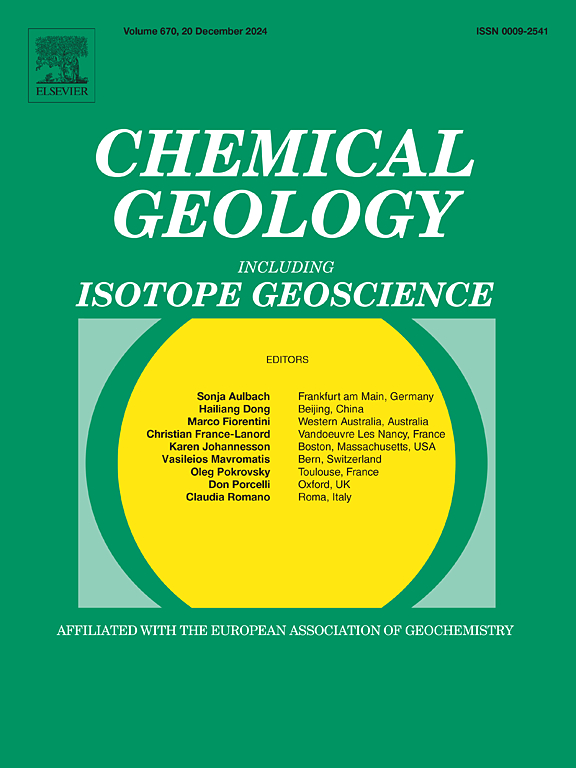Variable sampling of distinct ancient mantle domains by the Iceland mantle plume over its 62 Ma eruption history
IF 3.6
2区 地球科学
Q1 GEOCHEMISTRY & GEOPHYSICS
引用次数: 0
Abstract
Mantle plumes produce geochemically diverse lavas over their lifetime, some of which preserve compositions derived from Earth's earliest events. Most studies of plume-related lavas in this context have focused on modern ocean island basalts (OIB), primarily because these are relatively free of geochemical influences from crustal assimilation that may obscure the compositions of their mantle sources. Notwithstanding, there is no a priori reason why a mantle plume should consistently tap the same mantle domain over geological time, which means that early plume-related magmas may preserve a perspective on the early Earth that complements that of modern OIB. This study expands a previous investigation of picrites with high 3He/4He ratios, a likely indicator for ancient, less degassed mantle domains, with new 142Nd/144Nd (n = 7) and 182W/184W (n = 2) data that, together with literature data, comprise a detailed short-lived radiogenic isotope database for the Iceland hotspot. Heterogeneous 142Nd/144Nd ratios in lavas from different stages of the Iceland plume imply that it has tapped a variety of early-formed mantle domains, in particular that the head of the Iceland plume rapidly shifted between tapping domains with distinct histories. This behavior may reflect both the higher buoyancy flux of plume heads as well as the petrological and physical properties of these domains. Together, these data highlight the importance of developing comprehensive, high-precision short-lived radiogenic isotope datasets for all stages of plume magmatism, since the geochemical compositions of modern OIB reflect only one set of mantle domains that can be potentially tapped by mantle plumes.
冰岛地幔柱在其62 Ma喷发历史上的不同古地幔域的可变采样
地幔柱在其一生中产生了地球化学上多样化的熔岩,其中一些熔岩保留了来自地球最早事件的成分。在这种背景下,大多数与羽流相关的熔岩研究都集中在现代洋岛玄武岩(OIB)上,主要是因为这些玄武岩相对不受地壳同化的地球化学影响,而地壳同化可能会掩盖其地幔源的成分。尽管如此,没有一个先验的原因可以解释为什么地幔柱在地质时期会一直接触同一个地幔域,这意味着早期与地幔柱相关的岩浆可能保留了早期地球的观点,补充了现代OIB的观点。本研究扩展了先前对高3He/4He比率(可能是古代,脱气较少的地幔域的指标)的硬橄岩的研究,使用新的142 /144Nd (n = 7)和182W/184W (n = 2)数据,以及文献数据,组成了冰岛热点的详细的短寿命放射性成因同位素数据库。冰岛羽流不同时期熔岩的142 /144Nd比值的不均匀性表明,冰岛羽流曾敲打过多种早期形成的地幔域,特别是冰岛羽流的头部在不同历史的敲打域之间快速移动。这种行为既反映了地幔柱头较高的浮力通量,也反映了这些区域的岩石学和物性。综上所述,这些数据强调了为地幔柱岩浆活动的所有阶段建立全面、高精度的短寿命放射性成因同位素数据集的重要性,因为现代OIB的地球化学成分只反映了一组地幔域,这些地幔域可能被地幔柱所利用。
本文章由计算机程序翻译,如有差异,请以英文原文为准。
求助全文
约1分钟内获得全文
求助全文
来源期刊

Chemical Geology
地学-地球化学与地球物理
CiteScore
7.20
自引率
10.30%
发文量
374
审稿时长
3.6 months
期刊介绍:
Chemical Geology is an international journal that publishes original research papers on isotopic and elemental geochemistry, geochronology and cosmochemistry.
The Journal focuses on chemical processes in igneous, metamorphic, and sedimentary petrology, low- and high-temperature aqueous solutions, biogeochemistry, the environment and cosmochemistry.
Papers that are field, experimentally, or computationally based are appropriate if they are of broad international interest. The Journal generally does not publish papers that are primarily of regional or local interest, or which are primarily focused on remediation and applied geochemistry.
The Journal also welcomes innovative papers dealing with significant analytical advances that are of wide interest in the community and extend significantly beyond the scope of what would be included in the methods section of a standard research paper.
 求助内容:
求助内容: 应助结果提醒方式:
应助结果提醒方式:


